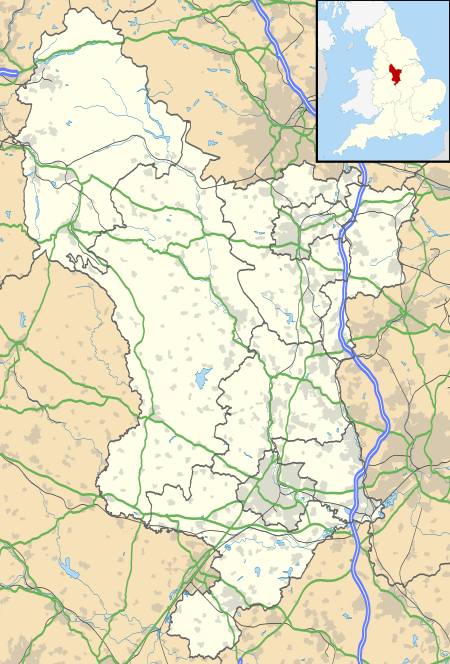Derbyshire
Derbyshire (/ˈdɑːrbɪˌʃɪər, -ʃər/[2]) is a county in the East Midlands of England. A substantial portion of the Peak District National Park lies within Derbyshire, containing the southern extremity of the Pennine range of hills which extend into the north of the county. The county contains part of the National Forest, and borders on Greater Manchester to the northwest, West Yorkshire to the north, South Yorkshire to the northeast, Nottinghamshire to the east, Leicestershire to the southeast, Staffordshire to the west and southwest and Cheshire also to the west. Kinder Scout, at 636 metres (2,087 ft), is the highest point in the county, whilst Trent Meadows, where the River Trent leaves Derbyshire, is its lowest point at 27 metres (89 ft).[3]:1[4] The River Derwent is the county's longest river at 66 miles (106 km), and runs roughly north to south through the county.[5] In 2003 the Ordnance Survey placed Church Flatts Farm at Coton in the Elms (near Swadlincote) as the farthest point from the sea in Great Britain.[6][7]
| Derbyshire | |||||
|---|---|---|---|---|---|
| Ceremonial county | |||||
| |||||
| Motto: Bene consulendo ("By wise deliberation") | |||||
 | |||||
| Coordinates: 53°8′N 1°36′W | |||||
| Sovereign state | United Kingdom | ||||
| Constituent country | England | ||||
| Region | East Midlands | ||||
| Established | Ancient | ||||
| Ceremonial county | |||||
| Lord Lieutenant | William Tucker | ||||
| High Sheriff | Anthony Walker[1] (2020–21) | ||||
| Area | 2,625 km2 (1,014 sq mi) | ||||
| • Ranked | 21st of 48 | ||||
| Population (mid-2019 est.) | 1,053,316 | ||||
| • Ranked | 21st of 48 | ||||
| Density | 401/km2 (1,040/sq mi) | ||||
| Ethnicity | 96.0% White 2.3% S. Asian 1.7% Black, Mixed Race or Chinese | ||||
| Non-metropolitan county | |||||
| County council | Derbyshire County Council | ||||
| Executive | Conservative | ||||
| Admin HQ | Matlock | ||||
| Area | 2,547 km2 (983 sq mi) | ||||
| • Ranked | 16nd of 26 | ||||
| Population | 802694 | ||||
| • Ranked | 11th of 26 | ||||
| Density | 315/km2 (820/sq mi) | ||||
| ISO 3166-2 | GB-DBY | ||||
| ONS code | 17 | ||||
| GSS code | E10000007 | ||||
| NUTS | UKF12, UKF13 | ||||
| Website | derbyshire | ||||
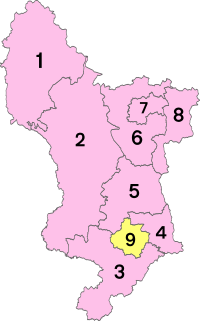 Districts of Derbyshire Unitary County council area | |||||
| Districts | |||||
| Members of Parliament | List of MPs | ||||
| Police | Derbyshire Constabulary | ||||
| Time zone | Greenwich Mean Time (UTC) | ||||
| • Summer (DST) | British Summer Time (UTC+1) | ||||
The city of Derby is a unitary authority area, but remains part of the ceremonial county of Derbyshire. The non-metropolitan county contains 30 towns with between 10,000 and 100,000 inhabitants. There is a large amount of sparsely populated agricultural upland: 75% of the population live in 25% of the area.
History
The area that is now Derbyshire was first visited, probably briefly, by humans 200,000 years ago during the Aveley interglacial as evidenced by a Middle Paleolithic Acheulean hand axe found near Hopton.[8]
Further occupation came with the Upper Paleolithic and Neolithic periods of the Stone Age when Mesolithic hunter gatherers roamed the hilly tundra.[9] Evidence of these nomadic tribes has been found in limestone caves located on the Nottinghamshire border. Deposits left in the caves date the occupancy at around 12,000 to 7,000 BCE.[10]
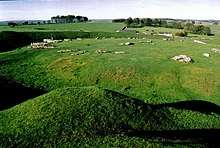
Burial mounds of Neolithic settlers are also situated throughout the county. These chambered tombs were designed for collective burial and are mostly located in the central Derbyshire region.[10] There are tombs at Minninglow and Five Wells that date back to between 2000 and 2500 BCE.[11] Three miles west of Youlgreave lies the Neolithic henge monument of Arbor Low, which has been dated to 2500 BCE.
It is not until the Bronze Age that real signs of agriculture and settlement are found in the county. In the moors of the Peak District signs of clearance, arable fields and hut circles were discovered after archaeological investigation. However this area and another settlement at Swarkestone are all that have been found.[12]
During the Roman invasion the invaders were attracted to Derbyshire because of the lead ore in the limestone hills of the area. They settled throughout the county with forts built near Brough in the Hope Valley and near Glossop. Later they settled around Buxton, famed for its warm springs, and set up a fort near modern-day Derby in an area now known as Little Chester.[12]
Several kings of Mercia are buried in the Repton area.[13]
Following the Norman Conquest, much of the county was subject to the forest laws. To the northwest was the Forest of High Peak under the custodianship of William Peverel and his descendants. The rest of the county was bestowed upon Henry de Ferrers, a part of it becoming Duffield Frith. In time the whole area was given to the Duchy of Lancaster. Meanwhile, the Forest of East Derbyshire covered the whole county to the east of the River Derwent from the reign of Henry II to that of Edward I.[14]
Geography
Most of Derbyshire consists of rolling hills and uplands, with the southern Pennines extending from the north of Derby[15] throughout the Peak District and into the north of the county, reaching the county's highest point at Kinder Scout.[16] The south and east of the county are generally lower around the valley of the River Trent, the Coal Measures, and the areas of clay and sandstones between the Peak District and the south west of the county. The main rivers in the county are the River Derwent and the River Dove which both join the River Trent in the south. The River Derwent rises in the moorland of Bleaklow and flows throughout the Peak District and county for the majority of its course, while the River Dove rises in Axe Edge Moor and forms a boundary between Derbyshire and Staffordshire for most of its length.
Landscape character
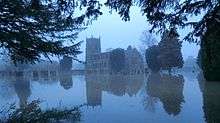
The varied landscapes within Derbyshire have been formed mainly as a consequence of the underlying geology, but also by the way the land has been managed and shaped by human activity. The county contains 11 discrete landscape types, known as National Character Areas, which have been described in detail by Natural England[17] and further refined, mapped and described by Derbyshire County Council[18] and the Peak District National Park.[19]
The 11 National Character Areas found within Derbyshire are:
- Dark Peak
- White Peak
- South West Peak
- Derbyshire Peak Fringe & Lower Derwent
- Nottinghamshire, Derbyshire & Yorkshire Coalfield
- Southern Magnesian Limestone
- Needwood & South Derbyshire Claylands
- Trent Valley Washlands
- Melbourne Parklands
- Leicestershire & South Derbyshire Coalfield
- Mease/Sence Lowlands
Geology
From a geological perspective, Derbyshire's solid geology can be split into two very different halves. The oldest rocks occur in the northern, more upland half of the county, and are mostly of Carboniferous age, comprising limestones, gritstones, sandstones and shales. In its north-east corner to the east of Bolsover there are also Magnesian Limestone rocks of Permian age. In contrast, the southern and more lowland half of Derbyshire contains much softer rocks, mainly mudstones and sandstones of Permo-Triassic age, which create gentler, more rolling landscapes with few rock outcrops. Across both regions can be found drift deposits of Quaternary age – mainly terrace and river gravel deposits and boulder clays. Landslip features are found on unstable layers of sandstones and shales, with Mam Tor and Alport Castles being the most well-known. Cemented screes and tufa deposits occur very rarely in the limestone dales and rivers, whilst cave systems have been created naturally in the limestone since Pleistocene times. The recent discovery of a system near Castleton, named Titan, is now known to have the deepest shaft and biggest chamber of any cave in Britain.[20]
The oldest rocks are Lower Carboniferous limestones of Dinantian age, which form the core of the White Peak within the Peak District National Park. Because northern Derbyshire is effectively an uplifted dome of rock layers which have subsequently eroded back to expose older rocks in the centre of that dome, these are encircled by progressively younger limestone rocks until they in turn give way on three sides to Upper Carboniferous shales, gritstones and sandstones of Namurian age.
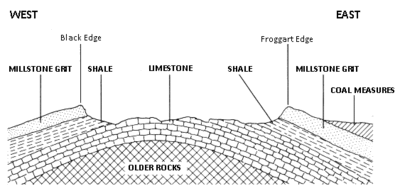
Younger still are the sandstones, shales and coal deposits found on the eastern flank of Derbyshire, forming the Coal Measures, which are of Westphalian age. All these rock layers disappear south of a line drawn between Ashbourne and Derby under layers of clays and sandstones (Mercia Mudstone Group and Sherwood Sandstones) of Permo-Triassic age. Small amounts of carboniferous limestones, gritstones and coal measures reappear in the far south of Derbyshire from Ticknall (limestone) to Swadlincote (coal measures).[21] Some areas of the White Peak exhibit contemporaneous basalt flows (e.g. Ravens Tor at Millers Dale), as well as subsequent dolerite sill intrusion at a much later stage (e.g.near Tideswell Dale),[22] whilst mineralisation of the carboniferous limestone in a subsequent period created extensive lead and fluorite deposits which have formed a significant part of Derbyshire's economy, as did coal mining. Lead mining has been important here since Roman Times.[23] The much more recent river gravels of the Trent valley remain a significant extractive industry today in south Derbyshire, as does the mining of limestone rock in central and northern parts of the county.[24] Coarse sandstones were once extensively quarried both for local building materials and for the production of gritstone grinding wheels for use in mills, and both former industries have left their mark on the Derbyshire landscape.
Green belts
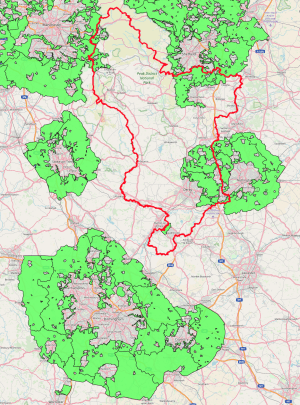
Clockwise from top left:
North West Green Belt
South and West Yorkshire Green Belt
Nottingham and Derby Green Belt
Burton upon Trent and Swadlincote Green Belt
West Midlands Green Belt
Stoke-on-Trent Green Belt
As well as the protections afforded to the Peak District area with national and local policies, there are several green belts within the county which aim to preserve the landscape surrounding main urban areas. There are four such areas,[25] the first three being portions of much larger green belts that extend outside the county and surround large conurbations:
| Derbyshire green belt area | Part of the larger | Communities contained within | Communities on the outskirts |
|---|---|---|---|
| North West Derbyshire Green Belt | North West Green Belt for Manchester | Glossop, Hadfield, Charlesworth, Furness Vale, New Mills | Hayfield, Chinley, Whaley Bridge |
| North East Derbyshire Green Belt | South and West Yorkshire Green Belt for Sheffield | Dronfield, Eckington, Killamarsh, High Lane/Ridgeway, Holymoorside | Chesterfield, Staveley, Barlborough |
| South East Derbyshire Green Belt | Nottingham and Derby Green Belt for Derby/Nottingham | Ilkeston, Long Eaton, Heanor, Ripley, Borrowash, Duffield, West Hallam | Belper, Derby |
| South Derbyshire Green Belt | Burton upon Trent and Swadlincote Green Belt | Stanhope Bretby, Stanton | Burton-upon-Trent, Swadlincote |
Ecology
Because of its central location in England, and its altitude range from 27 metres in the south to 636 metres in the north,[3]:1 Derbyshire contains many species at the edge of their UK distribution ranges. Some species with a predominantly northern British distribution are at the southern limit of their range, whilst others with a more southern distribution are at their northern limit in Derbyshire. As climate change progresses, a number of sensitive species are now being seen to be either expanding or contracting their range as a result.[3]:314 For the purposes of protecting and recording the county's most important habitats, Derbyshire has been split into two regions, each with its own Biodiversity Action Plan (BAP), based around National Character Areas. The Peak District BAP includes all of Derbyshire's uplands of the Dark Peak, South-West Peak and White Peak, including area of limestone beyond the national park boundary.[26] The remaining areas are monitored and recorded in the Lowland Derbyshire Biodiversity Action Plan, which subdivides the landscape into eight smaller Action Areas.[27]
The Derbyshire Biological Records Centre was formerly based at Derby Museum & Art Gallery, but since 2011 has been managed by Derbyshire Wildlife Trust.[28] Two of Englands 48 Local Nature Partnerships (LNP) also cover Derbyshire; these are the Peak District LNP and the Lowland Derbyshire & Nottinghamshire LNP.[29]
Botany
Since 2002, the county flower for Derbyshire has been Jacob's-ladder (Polemonium caeruleum), a relatively rare species, and very characteristic of certain limestone dales in the White Peak.[3]:187 Derbyshire is known to have contained 1,919 separate taxa of vascular plants (including species, hybrids and micro-species) since modern recording began,[3]:409 of which 1,133 are known to be either native or archaeophyte, the remainder being non-native species. These comprise 336 established species, 433 casuals and 17 unassigned. It is known that 34 species of plants once native here have been lost from Derbyshire (i.e. become locally extinct) since modern plant recording began in the 17th century.[3]:410 Derbyshire contains two endemic vascular plants, found nowhere else in the world: Rubus durescens, occurring in central Derbyshire,[3]:89 and Derby hawkweed (Hieracium naviense), still known only from Winnats Pass.[3]:263 One endemic species of moss, Derbyshire Feather Moss, occurs in one small 3-metre patch in just one Derbyshire limestone dale, its sole world location intentionally kept confidential.[30]
The distribution and status of vascular plants in Derbyshire have been recorded over the last 120 years in a series of four major botanical works, each by different authors between 1889 and 2015, but all entitled The Flora of Derbyshire. Plant recording is mainly undertaken locally by volunteers from the Derbyshire Flora Group,[3]:406 and by staff at Derbyshire Wildlife Trust and the Peak District National Park.

The Dark Peak is characterised by heathlands, bogs, gritstone edges and acid grasslands containing relatively few species, with plants such as heather (Calluna vulgaris), crowberry (Empetrum nigrum), bilberry (Vaccinium myrtillus) and hare's-tail cotton grass (Eriophorum vaginatum) being dominant on the high moors.[3]:6 The dales of the White Peak are known for habitats such as calcareous grassland, ash woodlands and rock outcrops in all of which a much greater richness of lime-loving species occurs than elsewhere in the county.[3]:4 These include various orchids (such as early purple orchid (Orchis mascula), dark-red helleborine (Epipactis atrorubens) and fly orchid (Ophrys insectifera)), common rockrose (Helianthemum nummularium), spring cinquefoil (Helianthemum nummularium) and grass of parnassus (Parnassia palustris). Specialised communities of plants occur on former lead workings, where typical metallophyte species include spring sandwort (Minuartia verna), alpine penny-cress (Thlaspi caerulescens) (both known locally in Derbyshire as Leadwort), as well as mountain pansy (Viola lutea) and moonwort (Botrychium lunaria).[3]:6[31]
As at 2015, Derbyshire contains 304 vascular plant species now designate as either of international, national or local conservation concern because of their rarity or recent declines, and are collectively listed as Derbyshire Red Data plants.[3]:418 Work on recording and publishing a bryophyte flora for Derbyshire is still ongoing; as at 2012 a total of 518 bryophyte species had been recorded for the county.[32][33]
Botanical recording in the UK predominantly uses the unchanging vice-county boundary system, which results in a slightly different map of Derbyshire from the modern geographic county.[3]:20
Zoology
A number of specialist organisations protect, promote and monitor records of individual animal groups across Derbyshire. The main ones are Derbyshire Ornithological Society; Derbyshire Mammal Group; Derbyshire Bat Group, Derbyshire Amphibian and Reptile Group, and the Derbyshire & Nottingham Entomological Society. All maintain databases of wildlife sightings, whilst some such as the Derbyshire Ornithological Society provide alerts of rare sightings on their websites or social media pages, and also publish major works describing the status and distribution of species.[34]
Economy
Derbyshire has a mixture of a rural economy in the west, with a former coal mining economy in the northeast (Bolsover district), the Erewash Valley around Ilkeston and in the south around Swadlincote. The rural landscape varies from arable farmland in the flat lands to the south of Derby, to upland pasture and moorland in the high gritstone uplands of the southern Pennines.
Derbyshire is rich in natural mineral resources such as lead, iron, coal, and limestone, which have been exploited over a long period—lead, for example, has been mined since Roman times. The limestone outcrops in the central area led to the establishment of large quarries to supply the industries of the surrounding towns with lime for building and steelmaking, and latterly in the 20th century cement manufacture. The industrial revolution also increased demand for building stone, and in the late 19th and early 20th century the railways' arrival led to a large number of stone quarries being established. This industry has left its mark on the countryside but is still a major industry: a lot of the stone is supplied as crushed stone for road building and concrete manufacture, and is moved by rail.
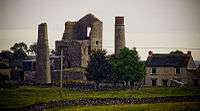
Derbyshire's relative remoteness in the late 18th century and an abundance of fast-flowing streams led to a proliferation of the use of hydropower at the beginning of the Industrial Revolution, following the mills pioneered by Richard Arkwright. Derbyshire has been said to be the home of the Industrial Revolution, and part of the Derwent Valley has been given World Heritage status in acknowledgement of this historic importance.
Nationally famous companies in Derbyshire include Rolls Royce, one of the world's leading aerospace companies, based since before World War I in Derby, Thorntons just south of Alfreton and Toyota, who have one of the UK's largest car manufacturing plants at Burnaston. Ashbourne Water used to be bottled in Buxton by Nestlé Waters UK until 2006 and Buxton Water still is.
Governance

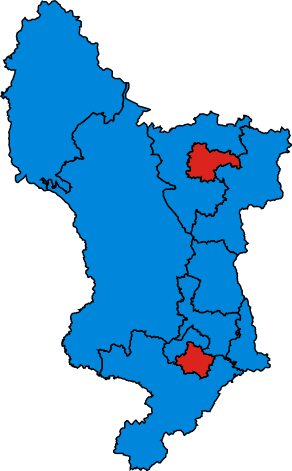
The county is divided into eleven constituencies for the election of members of parliament (MPs) to the House of Commons. As of December 2019, nine constituencies are represented by Conservative MPs, whilst the remaining two are represented by Labour MPs.[35]
Derbyshire has a three-tier local government since the local government reorganisation in 1974. It has a county council based in Matlock and eight district councils and since 1997, a unitary authority area of the City of Derby. Derby remains part of Derbyshire only for ceremonial purposes.
Derbyshire has become fractionally smaller during government reorganisation over the years. The Sheffield suburbs Woodseats, Beauchief, Handsworth, Woodhouse, Norton, Mosborough, Totley, Bradway and Dore were previously parts of the county, but were lost to Sheffield between 1900 and 1933, and Mosborough transferred in 1967. Marple Bridge was transferred to the Metropolitan Borough of Stockport in Greater Manchester. However, Derbyshire gained part of the Longdendale valley and Tintwistle from Cheshire in 1974. The current area of the geographic/ceremonial county of Derbyshire is only 4.7 square kilometres less than it was over 100 years ago.[3]:1[3]:20
At the third tier are the parish councils, which do not cover all areas. The eight district councils in Derbyshire and the unitary authority of Derby are shown in the map above.
These district councils are responsible for local planning and building control, local roads, council housing, environmental health, markets and fairs, refuse collection and recycling, cemeteries and crematoria, leisure services, parks, and tourism.[36] Education, social services, libraries, main roads, public transport, policing and fire services, Trading Standards, waste disposal and strategic planning are the responsibility of the County Council.[36]
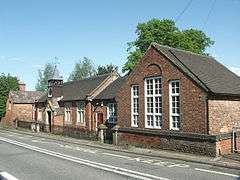
Although Derbyshire is in the East Midlands, some parts, such as High Peak (which incorporated former areas of Cheshire after boundary changes in 1974), are closer to the northern cities of Manchester and Sheffield and these parts do receive services which are more affiliated with northern England; for example, the North West Ambulance Service, Granada Television and United Utilities serve the Glossop area and the NHS Trusts here are governed by the Greater Manchester Health Authority. Outside the main city of Derby, the largest town in the county is Chesterfield.
Education
The Derbyshire school system is comprehensive with no selective schools. The independent sector includes Repton School, Ockbrook School, Trent College and The Elms School.
Settlements
There are several towns in the county with Derby being the largest and most populous. At the time of the 2011 census, a population of 770,600 lived in the county with 248,752 (32%) living in Derby. The table below shows all towns with over 10,000 inhabitants.
| Rank | Town | Population | Borough/District | Notes |
|---|---|---|---|---|
| 1 | Derby | 248,752 (2011)[37] | City of Derby | |
| 2 | Chesterfield | 103,788 (2011)[38] | Chesterfield | |
| 3 | Long Eaton | 45,000 | Erewash | |
| 4 | Ilkeston | 38,640 (2011) | Erewash | |
| 5 | Swadlincote | 36,000 (2004) | South Derbyshire | |
| 6 | Belper | 21,823 (2011)[39] | Amber Valley | Figure is for Belper civil parish, which includes Milford and Blackbrook |
| 7 | Dronfield | 21,261 (2011)[40] | North East Derbyshire | Figure is for Dronfield civil parish, which includes Dronfield Woodhouse and Coal Aston |
| 8 | Buxton | 20,836 (2001) | High Peak | |
| 9 | Ripley | 20,807 (2011)[41] | Amber Valley | Figure is for Ripley civil parish, which includes Heage, Ambergate and Waingroves |
| 10 | Staveley | 18,247 (2011)[42] | Chesterfield | Figure is for Staveley civil parish, which includes Mastin Moor, Duckmanton, Inkersall Green and Hollingwood |
| 11 | Glossop | 17,576 (2011)[43][44][45][46][47] | High Peak | Figure is for the electoral wards of Howard Town, Old Glossop, Dinting, Simmondley and Whitfield. |
| 12 | Heanor | 17,251 (2011)[48] | Amber Valley | Figure is for Heanor and Loscoe civil parish, which includes Loscoe but excludes Heanor Gate |
| 13 | Bolsover | 11,673 (2011)[49] | Bolsover | Figure is for Old Bolsover civil parish, which includes Shuttlewood, Stanfree and Whaley, but excludes part of Hillstown. |
| 14 | Eckington | 11,855 (2011)[50] | North East Derbyshire | Figure is for Eckington civil parish, which includes Renishaw, Spinkhill, Marsh Lane and Ridgeway. |
Historic areas
Some settlements which were historically part of the county now fall under the counties of Greater Manchester, Leicestershire, South Yorkshire, and Staffordshire:
| Cheshire/Greater Manchester | Marple Bridge (historically part of Marple) |
|---|---|
| Leicestershire | Measham |
| South Yorkshire | Mosborough, Totley, Dore |
| Staffordshire | Burton-upon-Trent (part) |
Sport
Derbyshire has one Football League team, Derby County, who play in the Championship, the second tier of English football. The next highest-placed team is Chesterfield, who participate in the National League, the fifth tier of English football. There are also many non-league teams playing throughout the county, most notably Alfreton Town, who play in the National League North.[51] The county is currently home to the world's oldest football club, Sheffield F.C., who play in Dronfield in north-east Derbyshire.[52] Glossop was the smallest town in the country to have a football team in the top tier of English football, Glossop North End.[53]
Derbyshire also has a cricket team based at the County Cricket Ground. Derbyshire County Cricket Club currently play in Division Two of the County Championship. There are also rugby league clubs based in the north of the county, the North Derbyshire Chargers and in Derby (Derby City RLFC). The county has numerous rugby union clubs, including Derby, Matlock, Ilkeston, Ashbourne, Bakewell and Amber Valley.
The county is a popular area for a variety of recreational sports such as rock climbing, hill walking, hang gliding, caving, sailing on its many reservoirs, and cycling along the many miles of disused rail tracks that have been turned into cycle trails, such as the Monsal Trail and High Peak Trail.
The town of Ashbourne in Derbyshire is known for its Royal Shrovetide Football, described as a "Medieval football game", played annually on Shrove Tuesday and Ash Wednesday.
Derbyshire is also host to one of the only community Muggle quidditch teams in the country, known as Derby Union Quidditch Club. The Club recruits players from the age of 16 upwards from all over Derby, and have representatives from most local sixth forms and the University of Derby. The team has competed against both the Leeds Griffins and the Leicester Lovegoods in the past and is part of the vibrant UK quidditch scene. It is also an official International Quidditch Association team.
Local attractions
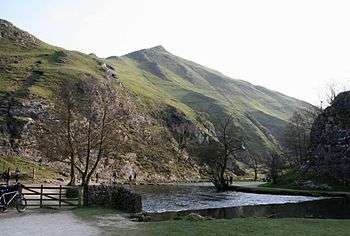
The county of Derbyshire has many attractions for both tourists and local people. The county offers Peak District scenery such as Mam Tor and Kinder Scout, and more metropolitan attractions such as Bakewell, Buxton and Derby. Local places of interest include Bolsover Castle, Castleton, Chatsworth House, National Tramway Museum at Crich, Peak Rail steam railway, Midland Railway steam railway, Dovedale, Haddon Hall, the Heights of Abraham and Matlock Bath.[54]
In the north of the county, three large reservoirs, Howden, Derwent and Ladybower, were built during the early part of the 20th century to supply the rapidly growing populations of Sheffield, Derby and Leicester with drinking water. The moorland catchment area around these is part of the Peak District National Park and is extensively used for leisure pursuits such as walking and cycling.
There are many properties and lands in the care of the National Trust that are open to the public, such as Calke Abbey, Hardwick Hall, High Peak Estate, Ilam Park, Kedleston Hall, Longshaw Estate near Hathersage, and Sudbury Hall on the Staffordshire border.
Notable gardens in Derbyshire include the formal gardens in the 17th–18th-century French style at Melbourne Hall south of Derby, the listed garden at Renishaw Hall near Eckington, Lea Rhododendron Gardens near Matlock, the Royal Horticultural Society recommended Bluebell Arboretum near Swadlincote, and the extensive gardens at Chatsworth House.
County emblems
As part of a 2002 marketing campaign, the plant conservation charity Plantlife chose the Jacob's-ladder as the county flower.
In September 2006, a proposal for a county flag was introduced, largely on the initiative of BBC Radio Derby.[55] The flag consists of a white-bordered dark green cross encompassing a golden Tudor rose (an historical symbol of the county) all set in a blue field. The blue field represents the many waters of the county, its rivers and reservoirs, while the cross is green to mark the great areas of countryside. The flag was subsequently registered with the Flag Institute as the flag of Derbyshire in September 2008.[56]
In 2015, BBC Radio Derby commissioned a Derbyshire anthem, entitled "Our Derbyshire", including lyrics suggested by its listeners. It received its first performance on 17 September 2015 at Derby Cathedral.
Demographics
| Derbyshire Compared | |||||
|---|---|---|---|---|---|
| UK Census 2011 | Derby[37] | Derbyshire[57] | East Midlands | England | |
| Total population | 248,752 | 769,686 | 4,533,222 | 53,012,456 | |
| Foreign born (outside Europe) | 9.3% | 1.4% | 6.4% | 9.3% | |
| White | 80.2% | 97.5% | 89.3% | 85.5% | |
| Asian | 12.6% | 1.1% | 6.4% | 7.7% | |
| Black | 3.0% | 0.4% | 1.7% | 3.4% | |
| Christian | 52.7% | 63.6% | 58.8% | 59.4% | |
| Muslim | 7.6% | 0.3% | 3.1% | 5.0% | |
| Hindu | 0.9% | 0.2% | 2.0% | 1.5% | |
| No religion | 27.6% | 28.0% | 27.5% | 24.7% | |
| Over 65 | 15.1% | 18.6% | 17.1% | 16.3% | |
| Unemployed | 5.2% | 3.9% | 4.2% | 4.4% | |
In 1801 the population was 147,481[58][59] According to the UK Census 2001 there were 956,301 people spread out over the county's 254,615 hectares.[60] This was estimated to have risen to 990,400 in 2006.[61]
The county's population grew by 3.0% from 1991 to 2001 which is around 21,100 people. This figure is higher than the national average of 2.65% but lower than the East Midlands average of 4.0%. The county as a whole has an average population density of 2.9 people per hectare making it less densely populated than England as a whole.[62] The density varies considerably throughout the county with the lowest being in the region of Derbyshire Dales at 0.88, and highest outside of the main cities in the region of Erewash which has 10.04 people per hectare.[63]
| Population since 1801 | ||||||||||||||
| Year | 1801 | 1851 | 1901 | 1911 | 1921 | 1931 | 1939 | 1951 | 1961 | 1971 | 1981 | 1991 | 2001 | 2011 |
|---|---|---|---|---|---|---|---|---|---|---|---|---|---|---|
| Derbyshire non-metropolitan county[58] |
132,786 | 223,414 | 465,896 | 542,697 | 565,826 | 590,470 | 613,301 | 637,645 | 651,284 | 666,013 | 687,404 | 717,935 | 734,585 | 769,686 |
| Derby unitary authority[59] |
14,695 | 48,506 | 118,469 | 132,188 | 142,824 | 154,316 | 167,321 | 181,423 | 199,578 | 219,558 | 214,424 | 225,296 | 221,716 | 248,752 |
| Total as a ceremonial county |
147,481 | 271,920 | 584,365 | 674,885 | 708,650 | 744,786 | 780,622 | 819,068 | 850,862 | 885,571 | 901,828 | 943,231 | 956,301 | 1,018,438 |
In literature and popular culture
In Jane Austen's novel Pride and Prejudice, Pemberley—the country home of Fitzwilliam Darcy—is situated in Derbyshire. In that novel, Chatsworth House in Derbyshire is named as one of the estates Elizabeth Bennet visits before arriving at Pemberley. In the 2005 film adaptation of the novel, Chatsworth House itself represents Pemberley. In one scene characters discuss visits to Matlock and Dovedale.
Sir Walter Scott's 1823 novel Peveril of the Peak is partly set in Derbyshire.
The events of Tom Stoppard's play Arcadia take place in the fictional country house of Sidley Park in Derbyshire.
Alfreton is mentioned in the novel Sons and Lovers by D. H. Lawrence, when a character gets a train to Alfreton and walks to Crich to see a lover.
George Eliot's novel Adam Bede is set in a fictional town based on Wirksworth.
Georgette Heyer's detective/romance novel The Toll-Gate is set in 1817 around a fictional toll-gate in Derbyshire.
The 1969 film Women in Love by Ken Russell had various scenes filmed in and around Elvaston Castle, most notably the Greco-Roman wrestling scene, which was filmed in the castle's Great Hall.
The 1986 film Lady Jane by Trevor Nunn, starring Helena Bonham Carter and Cary Elwes, has scenes filmed at Haddon Hall.
The 1987 film The Princess Bride by Rob Reiner, starring Robin Wright and Cary Elwes, was partly filmed in Derbyshire. It included scenes at Haddon Hall and in the White Peak and Dark Peak.
The 1988 film The Lair of the White Worm by Ken Russell, starring Hugh Grant, was filmed in Derbyshire. The opening title sequence is of Thor's Cave in the Manifold valley.
The 1993–2002 TV series Peak Practice was set in Crich and Fritchley, except for the twelfth and final series, and originally starred Kevin Whately and Amanda Burton.[64] In 2003 an unrelated and less successful medical TV drama, Sweet Medicine, was mostly filmed in the historic market town of Wirksworth.
Other Derbyshire locations in which British TV scenes have been filmed include:[65]
- Alderwasley: Stig of the Dump
- Ashbourne and Vernon Street in Derby: Nanny
- Chesterfield: The twisted spire of Church of St Mary and All Saints, Chesterfield, was made famous by its use in the opening credits of the 1966–1971 ecclesiastical BBC TV sitcom All Gas and Gaiters, featuring Derek Nimmo.
- Hadfield: The League of Gentlemen
- Repton and especially Repton School: Goodbye, Mr. Chips (in both 1939 and 1983 versions)
- Shirebrook: The Full Monty
- Wingfield Manor: 1980s BBC TV series of The Chronicles of Narnia
See also
References
- "No. 62943". The London Gazette. 13 March 2020. p. 5161.
- "Derbyshire". CollinsDictionary.com. HarperCollins. Retrieved 29 May 2020.
- Willmot, Alan; Moyes, Nick (2015). The Flora of Derbyshire. Pisces Publication. ISBN 978-1-874357-65-0.
- Haran, Brady. "Experiencing the Highs and Lows". BBC. Archived from the original on 12 August 2017. Retrieved 28 September 2015.
- 1:50 000 Scale Colour Raster (Map). Ordnance Survey. 2000.
- "BBC report centre of England". Archived from the original on 6 March 2012. Retrieved 3 April 2011.
- "Ordnance Survey – MapZone". Archived from the original on 30 September 2011. Retrieved 3 April 2011.
- "A Palaeolith from Hopton, Derbyshire Archaeological Journal 79". Cockerton, R. W. P. 1954: 153–155. Cite journal requires
|journal=(help) - Smith, p. 6
- Pevsner, p. 22
- Smith, p. 7
- Smith, p. 8
- "Repton in Derbyshire". Derbyshire UK. Archived from the original on 18 November 2007. Retrieved 7 January 2008.
- Barret, Dave. "Derbyshire County Council, East Midlands Archaeological Research Framework: Resource Assessment of Medieval Derbyshire" (PDF). Archived from the original (PDF) on 28 February 2008. Retrieved 7 January 2008.
- "City Centre Conservation Area" (pdf). Derby City Council. Derby City Council. Retrieved 21 August 2018.
- "About High Peak". visitderbyshire.co.uk. Archived from the original on 27 April 2017. Retrieved 26 April 2017.
- "National Character Area profiles: data for local decision making". Natural England. Archived from the original on 26 September 2015. Retrieved 17 August 2015.
- "Landscape Character". Derbyshire County Council. 2013. Archived from the original on 23 September 2015. Retrieved 17 August 2015.
- "Landscape Strategy" Archived 6 September 2015 at the Wayback Machine Peak District National Park, retrieved 20 August 2015
- "Cave boasts UK's biggest chamber". BBC News. 8 November 2006. Archived from the original on 6 March 2016. Retrieved 18 August 2015.
- "A Building Stone Atlas of Derbyshire & The Peak National Park", English Heritage, September 2011, retrieved 17 August 2015
- "Rocks and Fossils" Archived 2 October 2015 at the Wayback Machine, Peakland Heritage website, retrieved 20 August 2015
- "The Peak District is a very interesting area geologically". Peak District Information. Cressbrook Multimedia. 2008. Archived from the original on 5 September 2015. Retrieved 17 August 2015.
- "Derby and Derbyshire Minerals Local Plan" Archived 4 March 2016 at the Wayback Machine, Derbyshire County Council and Derby City Council, Adopted April 2000 (revised 2002, currently under review in 2015), retrieved 17 August 2015
- "Technical Assessment of the Derby Principal Urban Area Green Belt Purposes" (PDF). Archived (PDF) from the original on 10 November 2017. Retrieved 24 November 2017.
- "Peak District Biodiversity Action Plan (BAP) 2011–2020" Archived 6 September 2015 at the Wayback Machine, Peak District National Pak website, retrieved 18 August 2015
- "Lowland Derbyshire Biodiversity Action Plan 2011–2020" Archived 14 August 2015 at the Wayback Machine, Lowland Derbyshire Biodiversity Partnership website, retrieved 18 August 2015
- "Derbyshire Biological Records Centre" Archived 6 September 2015 at the Wayback Machine, Derbyshire Wildlife Trust website, retrieved 18 August 2015
- "Map of Local Nature Partnerships" Archived 13 January 2016 at the Wayback Machine, Natural England/DEFRA website, retrieved 18 August 2015
- Hodgketts, Nick G. (March 2001). "Thamnobryum angustifolium: Derbyshire feather-moss" (PDF). Joint Nature Conservation Committee. Archived from the original (PDF) on 10 December 2015. Retrieved 2 October 2017.
- "Biodiversity Action Plan – The Lead Legacy". Peak District. 2004. Archived from the original on 20 July 2011. Retrieved 17 August 2015.
- Blockeel, Tom "Bryophytes" Archived 11 September 2015 at the Wayback Machine, Derbyshire Wildlife Trust website, July 2013, retrieved 17 August 2015
- Blockeel, Tom "A Bryological Tour through Derbyshire (v.-c.57)" Archived 4 June 2016 at the Wayback Machine, British Bryological Society website, 18 January 2004, retrieved 17 August 2015
- "Derbyshire Ornithological Society" Archived 8 February 2018 at the Wayback Machine, retrieved 18 August 2015
- Jones, Caroline (9 June 2017). "The full General Election 2017 results for Derby and Derbyshire". Derby Telegraph. Archived from the original on 9 June 2017. Retrieved 9 June 2017.
- "Glossary of Local Government Terms". The Local Channel. Archived from the original on 14 March 2008. Retrieved 7 January 2008.
- UK Census (2011). "Local Area Report – Derby Local Authority (1946157129)". Nomis. Office for National Statistics. Retrieved 10 March 2018.
- UK Census (2011). "Local Area Report – Chesterfield Local Authority (1946157135)". Nomis. Office for National Statistics. Retrieved 10 March 2018.
- UK Census (2011). "Local Area Report – Belper Parish (1170212697)". Nomis. Office for National Statistics. Retrieved 10 March 2018.
- UK Census (2011). "Local Area Report – Dronfield Parish (1170212892)". Nomis. Office for National Statistics. Retrieved 10 March 2018.
- UK Census (2011). "Local Area Report – Ripley Parish (1170212716)". Nomis. Office for National Statistics. Retrieved 10 March 2018.
- UK Census (2011). "Local Area Report – Staveley Parish (1170212740)". Nomis. Office for National Statistics. Retrieved 10 March 2018.
- UK Census (2011). "Local Area Report – Howard Town 2011 Census Ward (1237322595)". Nomis. Office for National Statistics. Retrieved 10 March 2018.
- UK Census (2011). "Local Area Report – Old Glossop 2011 Census Ward (1170212704)". Nomis. Office for National Statistics. Retrieved 10 March 2018.
- UK Census (2011). "Local Area Report – Dinting 2011 Census Ward (1237322589)". Nomis. Office for National Statistics. Retrieved 10 March 2018.
- UK Census (2011). "Local Area Report – Simmondley 2011 Census Ward (1237322603)". Nomis. Office for National Statistics. Retrieved 10 March 2018.
- UK Census (2011). "Local Area Report – Whitfield 2011 Census Ward (1237322608)". Nomis. Office for National Statistics. Retrieved 10 March 2018.
- UK Census (2011). "Local Area Report – Heanor and Loscoe Parish (1170212704)". Nomis. Office for National Statistics. Retrieved 10 March 2018.
- UK Census (2011). "Local Area Report – Old Bolsover Parish (1170212732)". Nomis. Office for National Statistics. Retrieved 10 March 2018.
- UK Census (2011). "Local Area Report – Eckington Parish (1170212732)". Nomis. Office for National Statistics. Retrieved 10 March 2018.
- "Official Website". Alfreton Town F.C. Archived from the original on 11 August 2015. Retrieved 17 August 2015.
- "Coach & Horses Ground". Sheffield FC. Archived from the original on 12 October 2014. Retrieved 8 October 2014.
- "Glossop North End History". Archived from the original on 12 October 2014. Retrieved 8 October 2014.
- Local Attractions Archived 10 May 2008 at the Wayback Machine. Retrieved 19 March 2008
- "Revealed – The Derbyshire Flag". BBC. Archived from the original on 21 February 2008. Retrieved 7 January 2008.
- Flag Institute. "Derbyshire". Archived from the original on 14 October 2017. Retrieved 13 October 2017.
- Derbyshire County Council (2011). "2011 Census". derbyshire.gov.uk. Archived from the original on 7 March 2016. Retrieved 2 January 2016.
- "Derbyshire: Total Population". A Vision of Britain Through Time. Great Britain Historical GIS Project. Archived from the original on 22 October 2012. Retrieved 29 January 2008.
- "Derby UA: Total Population". A Vision of Britain Through Time. Great Britain Historical GIS Project. Archived from the original on 17 October 2007. Retrieved 31 January 2008.
- "Derbyshire: Total area, in hectares". A Vision of Britain Through Time. Great Britain Historical GIS Project. Archived from the original on 22 October 2012. Retrieved 29 January 2008.
- "T 09: Quinary age groups and sex for local authorities in the United Kingdom; estimated resident population Mid-2006 Population Estimates". Office for National Statistics. Archived from the original on 2 March 2009. Retrieved 20 October 2007.
- Research and Information Team (19 March 2003). "2001 Census: Key Statistics for Derbyshire" (PDF). derbyshiredales.gov.uk. Archived from the original (PDF) on 28 February 2008. Retrieved 29 January 2008.
- United Kingdom Census 2001 (2001). "Area: Derbyshire (Education Authority)". neighbourhood.statistics.gov.uk. Archived from the original on 12 June 2011. Retrieved 24 October 2007.
- "Peak Practice" Archived 24 September 2015 at the Wayback Machine, BBC Derby, 24 September 2014, retrieved 20 August 2015
- "Derbyshire on TV and Film" Archived 24 September 2015 at the Wayback Machine, BBC Derby, 27 September 2014, retrieved 20 August 2015
Further reading
- Smith, Roly (1999). Towns & Villages of Britain: Derbyshire. Cheshire: Sigma Press. ISBN 1-85058-622-5.
- Pevsner, Nikolaus (1953). The Buildings of England: Derbyshire. Middlesex: Penguin Books. ISBN 0-14-071008-6.
- Pevsner & Williamson, Elizabeth (1978). The Buildings of England: Derbyshire. Penguin Books. ISBN 0-14-071008-6.
- Willmot, Alan; Moyes, Nick (2015). The Flora of Derbyshire. Pisces Publication. ISBN 978-1-874357-65-0.
- Frost, Roy; Shaw, Steve (2014). The Birds of Derbyshire. Liverpool University Press. ISBN 9781846319563.
- Alston, Debbie; Mallon, Dave; Whiteley, Derek (2013). The Mammals of Derbyshire. Derbyshire Mammal Group and Sorby Natural History Society. ISBN 9780950039688.
- Cope, F. Wolverson (1998). Geology Explained in the Peak District. Scarthin Books. ISBN 0907758983.
External links
| Wikimedia Commons has media related to Derbyshire. |
| Wikivoyage has a travel guide for Derbyshire. |
- Derbyshire Heritage - derbyshireheritage.co.uk
- artsderbyshire.org.uk – Derby and Derbyshire arts guide
- Derbyshire Extensive Urban Survey English Heritage and Derbyshire County Council
- Derbyshire at Curlie
- Flora of Derbyshire – Maps and information on vascular plant distribution
- Images of Derbyshire at the Historic England Archive


